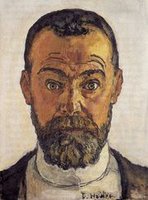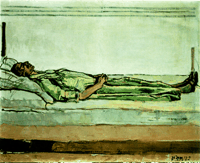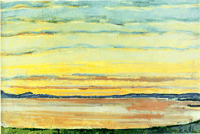
While doing some research on the Swiss painter Ferdinand Hodler (1853-1918) I came across an artical aimed at Oncologist (Cancer doctors) that Hodler made of his beloved Valentine Godé-Darel before, during, and after her illness. Below are the highlights of this unusual subject.
In January 1914, only 3 months after the birth of their daughter, Pauline, Godé-Darel had an operation for a gynecologic cancer, from which she died 1 year later. Between 1912 and 1915, Hodler painted her many times. He documented her wasting and eventual extinction without mercy and yet with intense sympathy. He created a series of paintings that force the viewer to face the process of dying. It may be helpful to an oncologist to sense his or her reaction to these visual stages of suffering. Figure 1, the youth. This portrait in shades of red from 1912 shows Godé-Darel as a beautiful, healthy young woman.




 Above is the agony. One day before her death, the patient has lost consciousness. The mouth is wide open; one imagines hearing a loud rattle. During this phase, it becomes impossible to communicate with the dying person. If it lasts a long time, death usually comes as a relief for the family and the nursing staff.
Above is the agony. One day before her death, the patient has lost consciousness. The mouth is wide open; one imagines hearing a loud rattle. During this phase, it becomes impossible to communicate with the dying person. If it lasts a long time, death usually comes as a relief for the family and the nursing staff. This is the last painting of the dead Godé-Darel. In this painting, made on January 26, 1915, day after her death, Hodler symbolically transforms the image. It is dominated by many horizontal lines. The blue stripes at the top appear to symbolize heaven, where the soul will disappear. The dark base of the bed points to an underground world. The header and the footer of the bed do not seem to be made of wood. Rather, the two brushstrokes may symbolize the measures of time, the beginning and the end.
This is the last painting of the dead Godé-Darel. In this painting, made on January 26, 1915, day after her death, Hodler symbolically transforms the image. It is dominated by many horizontal lines. The blue stripes at the top appear to symbolize heaven, where the soul will disappear. The dark base of the bed points to an underground world. The header and the footer of the bed do not seem to be made of wood. Rather, the two brushstrokes may symbolize the measures of time, the beginning and the end.

No comments:
Post a Comment